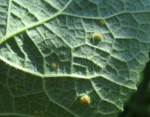 Rusts are considered one of the most harmful diseases of plants. They are caused by fungi that can infect the leaves, stems, fruits, or seeds of plants, producing pustules on the plant surface that can be yellow, orange, red, rust, brown or black. The rust may seriously weaken the plant but does not necessarily kill it. Wheat rust is perhaps the most well-known of these deadly diseases, but many garden plants are affected by rusts, causing unsightly damage.
Rusts are considered one of the most harmful diseases of plants. They are caused by fungi that can infect the leaves, stems, fruits, or seeds of plants, producing pustules on the plant surface that can be yellow, orange, red, rust, brown or black. The rust may seriously weaken the plant but does not necessarily kill it. Wheat rust is perhaps the most well-known of these deadly diseases, but many garden plants are affected by rusts, causing unsightly damage.
Here are some interesting facts about rusts that attack flowering plants.
 There are thousands of different kinds of fungi that cause rust.
There are thousands of different kinds of fungi that cause rust.
 All rusts are obligate parasites, that is, they must have at least one living host to complete their life cycle.
All rusts are obligate parasites, that is, they must have at least one living host to complete their life cycle.
 Some rust fungi require one host to complete their life cycle but others require two.
Some rust fungi require one host to complete their life cycle but others require two.
 The “rust” that you see as pustules on the plant are actually clusters of structures that bear spores called sori.
The “rust” that you see as pustules on the plant are actually clusters of structures that bear spores called sori.
 Rust is spread by spores.
Rust is spread by spores.
 Rust spores are spread by wind, water, or insects.
Rust spores are spread by wind, water, or insects.
 Rust develops when moisture conditions are optimal.
Rust develops when moisture conditions are optimal.
 Herbaceous garden plants affected by rust include hollyhock, snapdragon, aster, chrysanthemum, pinks, bee balm, and roses.
Herbaceous garden plants affected by rust include hollyhock, snapdragon, aster, chrysanthemum, pinks, bee balm, and roses.
Rust is not easy to control and preventative measures are a good place to start. Here are suggestions for controlling rust.
 Use disease resistant varieties ( for example, Aster ‘Crimson Beauty,” ‘Honeysong Pink’, ‘Purple Dome;’ hollyhock ‘Happy Lights”; snapdragon ‘White Monarch,’ ‘Orange Glow,’ the Rocket series).
Use disease resistant varieties ( for example, Aster ‘Crimson Beauty,” ‘Honeysong Pink’, ‘Purple Dome;’ hollyhock ‘Happy Lights”; snapdragon ‘White Monarch,’ ‘Orange Glow,’ the Rocket series).
 Space plants so that they have good air circulation.
Space plants so that they have good air circulation.
 Water in the morning, never at night, so that foliage dries quickly; use drip irrigation if possible.
Water in the morning, never at night, so that foliage dries quickly; use drip irrigation if possible.
 Remove and destroy all infected plant material to reduce the number of spores available for dispersal.
Remove and destroy all infected plant material to reduce the number of spores available for dispersal.
 Sulfar dust, and commercial fungicides that contain chlorothalonil, mancozeb, myclobutanil, or trifloxystrobin.
Sulfar dust, and commercial fungicides that contain chlorothalonil, mancozeb, myclobutanil, or trifloxystrobin.
